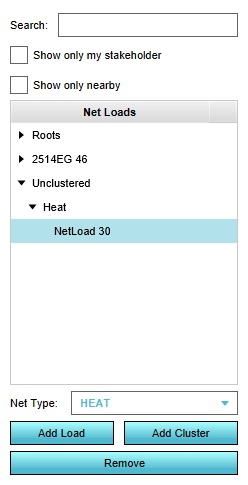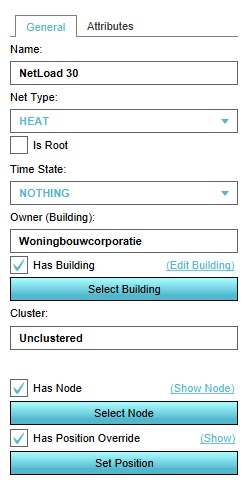Net Load
What are net loads
A load, in network simulation terms, is a supply or demand on a resource transport and distribution network. Such a network is composed of nodes connected by lines, in which the nodes with supply or demand are known as load nodes. Based on the supply and demand of various nodes in the network, it is possible to calculate the amount of resource flowing over the various lines.
How net loads relate to the Tygron Engine
In the Tygron Engine, a net load is a definition of supply or demand which connects to a net node to turn that node into a load node. A net load does have a geographical location in the 3D World which may be different from the net node is belongs to. Loads can be imagined as being the (geographical) destinations or origins of resources such as gas or electricity for GAS and ELECTRICITY networks respectively, while the net nodes and net lines form the extent of the distribution network.
Properties of net loads
Net loads have a number of properties related to their effect on the network. They also allow for the definitions of arbitrary attributes.
Name
The name of the net load is generally not visible to the end user, but can be used to keep track of specific net loads while editing, or could be called up using TQL to display more information to an end user.
Net Type
The network type this net load belongs to. Each net load can only belong to one type of network.
Root
The root net load indicates a reference net node or origin within the distribution network. Depending on the use-case, the root net load is often a resource supplier, although the net load can have any value for its supply or demand of resources. The Tygron Engine's built-in algorithm for generating networks requires that a root net load is present. This property is also signified by the ROOT_LOAD attribute.
Time state
The time state of the net load indicates whether or not the net load is to be considered active in the network. The following time states are relevant for a net load:
- NOTHING: The net load is currently not active, and its supply/demand should be ignored.
- READY: The net load is currently active, and its supply/demand should be taken into account for calculations.
- REQUEST_CONSTRUCTION_APPROVAL: The load is currently not active, but the owner of the network would like to make it active, requiring permission of the load owner.
- REQUEST_ZONING_APPROVAL: The net load is currently not active, but the owner of the load would like to make it active, requiring permission of the network owner.
When requesting the time state of a net cluster, the furthest progressed time state among all net loads in the net cluster is returned.
Owner
The net load can be owned by at most one stakeholder. If the net load is linked to a building, the owner of that building becomes the owner of the net load. If the net load is part of a cluster, the owner of that cluster becomes the owner of the net load. When the net load is both linked to a building and part of a cluster, the owner of the cluster takes precedence over the owner of the building.
Building
When a net load is created or loaded in directly over a building, the load is linked to that building. This allows for queries to find the properties of constructions based on the state of the network. Additionally, the owner of the building will also become the owner of the net load, for as long as the net load is linked to that building, and the net load is not part of a cluster owned by a different stakeholder. Net loads are not required to be linked to buildings.
Attributes
Net loads can have any number of arbitrary attributes. One attribute name is reserved and has a special function.
FLOW: The flow of a net load indicates the quantity of supply or demand that this net load represents. Positive numbers indicate a demand, and negative numbers indicate a supply. The flow is not a fixed property, but should be added to the net load as an attribute. By default, the attribute name FLOW is preferred. The specific attribute name used for this is defined as part of the settings of the net type. "FLOW" is the default attribute used to indicate this property, but any attribute may be used. Other attributes may also be used to serve the same purpose, even when they are not set to be the transport attribute in the network settings.
ROOT_LOAD: This attribute indicates whether this net load is a root of the network. A "1" indicates that this net load is indeed a root. A "0", or lack of this attribute, means that this net load isn't a root.
Adding and editing net loads
It is possible to add and edit net loads manually, but also to import net loads into the project.
Manually editing
It is possible to define each net load manually, using the built-in editing options.
Adding/removing net loads

In the overview of net loads, all net loads are automatically displayed grouped into their clusters, or into the groups "Roots" (for root loads) or "unclustered" (for loads which are not part of a cluster). Within these clusters, the net loads are then grouped by network type (i.e. HEAT, GAS, etc).
- Select the desired Net Type.
- Select "Add Load".
- Select the cluster the net load is in (or Roots or Unclustered if the load is a root or unclustered.
- Select the specific net load you wish to remove.
- Select "Remove".
Changing net loads

Name

- The name of the net load. This is generally not visible to the end-user. You can change this by altering the text in the "Name" field.
Net Type

- The network type this load belongs to. You can change this by selecting a different network type from the dropdown menu.
Is Root

- If this checkbox for "Is Root" is checked, this load is a root load. This means that this load is a producer in the network.
Time state

- Whether or not the net load is connected, or in what step of the process this load resides. You can change this by selecting a different time state from the dropdown menu.
Building

- A load can be associated with a building. To do this, select "Select Building", and select a construction in the 3D world. To remove the association with a building, uncheck the "Has Building" checkbox.
Node

- A load can be associated with a node. To do this, select "Select Building", and select a node in the 3D world. To remove the association with a node, uncheck the "Has Node" checkbox.
Position

- A load can have an explicitly determined position. To set its position, select "Set Position", and use the brush to select a location. To restore its position to the default location (or remove it from the 3D world when the load does not have a default location, uncheck the "Set Position" checkbox.
Importing GeoJSON
It is possible to import a geojson file to add net loads to a project.
It is also possible to select the option of importing data in the Net wizard. In both cases, it is recommended to import all network geojson files at the same time where possible: net lines, net line definitions, and net loads.
The net loads GeoJSON file should be composed of point data with the following attributes.
| Attribute | Description | Example | Remark |
|---|---|---|---|
| NAME | The name of the net load. | NetLoad 49 | |
| NET_TYPE | The type of network this net load belongs to | HEAT | Note that when connecting net loads and net nodes or net lines of different network types while importing, this is considered incorrect input and behavior of the Tygron Engine will be undefined. |
| STATE | Whether the net load is connected or not. | NOTHING | Any of the timestates mentioned in this article are valid. |
| NODE_ID | The ID of the net node this load belongs to. | 17 | If this file is being imported along with a net lines file, this NODE_ID should match one of the net lines START_NODE_IDs or END_NODE_IDs. |
| CLUSTER_ID | The ID of the cluster this load should belong to. | 4 | The cluster of net loads this net load should belong to. A cluster is not created automatically, but after importing these clusters can be created using a cluster generation algorithm. |
| ROOT_LOAD | Whether this net load is a root load or not | 0 | 1 = root load (producer), 0 = a regular load (consumer) |
| ADDRESSCODE | The postcode this net load is related to. | 2514EG 46 | When a net load has a postcode which is also found in a building in the 3D world, the net load is automatically linked to that building. |
